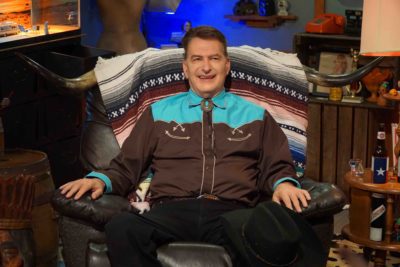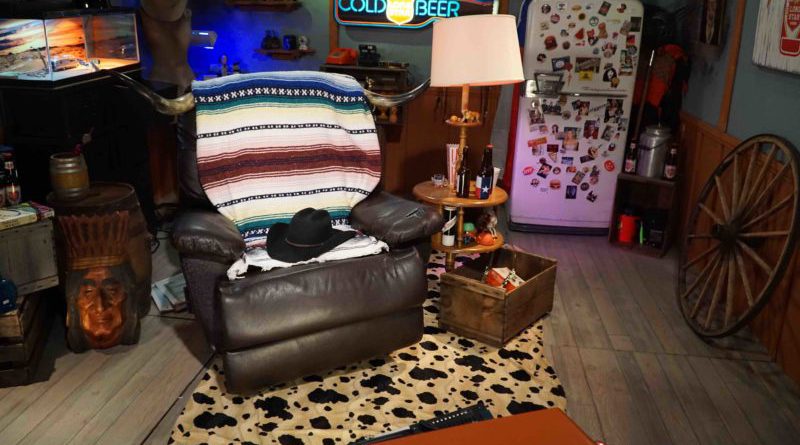INTERVIEW: Joe Bob Briggs is back with new movie marathon

Above photo: Joe Bob Briggs is gearing up to host more horror movies, this time on Shudder, AMC’s horror streaming service. Photo courtesy of Joe Bob Briggs representation / Provided with permission.
Among horror fans, there’s an endearing love for the old-time TV hosts who would introduce (and sometimes poke fun at) genre movies during late-night screenings. Many adults in the United States have fond memories of tuning in on a summer’s evening to watch Zacherley, Elvira or Vampira — personalities who would lead audiences through a treasure trove of horror flicks, exploitation movies and cult classics.
One of the most prominent genre hosts is Joe Bob Briggs, the satirist behind Joe Bob’s Drive-In Theater on The Movie Channel and then MonsterVision on TNT. He also did some acting over the years, perhaps most notably in Martin Scorsese’s Casino.
Briggs, whose real name is John Bloom, finished his steady TV work more than 17 years ago, and now he’s back for a horror movie marathon Friday, July 13 at 9 p.m. (Friday the 13th, of course) on Shudder, AMC’s horror streaming service.
“The people that put this together wanted a reboot of the old MonterVision format that I used to do on the TNT show, which absolutely slays me because that’s a long time ago,” Briggs said in a recent phone interview. “It’s a 24-hour marathon. It’s actually going to end up more like a 26- or 27-hour marathon because it’s 13 movies on Friday the 13th, and because we’re duplicating that old format, we have commercial interruptions on a network that has no commercials. So it’s kind of an insane format. It has everything that I used to do on that show. … I’ve been amazed by the number of people who have tweeted about it and emailed me about it and really are looking forward to it. Stephen King wrote a very laudatory thing about it, so I’m cautiously optimistic that a lot of people are going to show up for this.”
BRINGING THE MARATHON TO LIFE
Briggs filmed the marathon segments in real time. He likes the feel of a live show, so only one take was used for each scene; he never repeated a sequence. The long, arduous part for him and the team was the planning and writing; the actual performance, where he dons his trademark cowboy hat and belt buckle, is all in a day’s work.
The films for the marathon come from Shudder’s library, which is voluminous. The streaming service has licenses to such hits as The Descent, The Legend of Boggy Creek, George A. Romero’s Day of the Dead and The Mothman Prophecies, among many, many others.
“I went through the list and made comments on the ones where I would definitely have something to say, either because I have a personal story about the film or a relationship with the filmmaker,” Briggs said. “We try to do a mixed bag: all-time great horror films, cult classics, so bad they’re good, all the different types of films that we used to have on MonsterVision and my previous show. I had a previous show called Joe Bob’s Drive-In Theater on The Movie Channel where we showed really the dregs of exploitation films. We showed some real stinkers on that show, but some of them I remember fondly because we had so much fun with them.”
Growing up, Briggs was a fan of all types of film, including exploitation, action, sci-fi and horror movies — anything that would play at his local drive-in theater. Oftentimes the films were not screened for critics (for obvious reasons), so he would head to the drive-in on opening night and enjoy a viewing. This led to a career as a movie critic and eventually a connection with the godfather of oddball cinema.
“I became friends with Roger Corman, and much of my criteria for how to judge the movies came from conversations with Roger,” he said. “All the drive-in totals, [including number of deaths, etc.], that’s straight from Roger’s theories about what should be in a good exploitation film, so I became a friend of the exploitation industry at a time when it was universally despised and still not even reviewed by the mainstream media.”
Often Briggs would highlight movies from the fringes, but nowadays many of these old movies, and certainly new genre titles, have gone mainstream. “Horror just had its best mainstream year in history,” he said. “One of the top grossing films of the year was Stephen King’s It. … The Best Picture for the Academy Award was a monster film: The Shape of Water. The indie film that got the most praise from the East Coast intellectuals was Get Out, a horror film. So, yeah, horror is definitely in the mainstream.”
He added: “The number-one thing that I love to hear is when [fans] come up and say, ‘I was embarrassed to like these films, and you legitimized my love of them.’ So they would discover my show and say, ‘Oh, it’s OK. I don’t have to feel bad. I don’t have to sneak around and disguise my preference for these films. Here’s a guy talking about them seriously.’ I get a lot of that. I’m amazed sometimes how young people were when they were watching that show because it was on late at night, and it’s really not for children. Apparently a lot of children were watching it.”
The Shudder marathon is being billed as The Last Drive-In, but that does not mean this is the last time Briggs will be on television or the streaming service. It seems he is taking the new gig one day at a time.
“I just approached it as a one-time thing, thinking they want to do this nostalgia hit for the ’80s and ’90s,” he said. “I didn’t really approach it as anything that we would continue after. That’s why we called it The Last Drive-in. I said, ‘Yeah, I’ll put on the hat and the belt buckle. … And we can dust off the old La-Z-Boy recliner and do it one more time and see how many people show up.’ To me, it’s kind of a one-time throwback thing. That’s why I say I’m kind of amazed there’s been so much online activity. So many people write to me asking … ‘Is this really going to be the last time?’ I thought the last time was in 2001, but for an extra $200, maybe we’ll do it again.”
Like most horror fans, Briggs has his favorite genre movies. His top-10 list, which is always evolving, has most of the mainstays in the horror canon, like The Texas Chainsaw Massacre, Night of the Living Dead, Suspiria, Re-Animator, Hellraiser and Basket Case.
One of his favorites, which will be shown during the marathon, is Tourist Trap, a film that Briggs believes deserves more attention. “The reason it’s in there is because I think it’s an unappreciated movie that flopped when it came out,” he said. “It came out in 1979. It stars Chuck Connors. Chuck Connors was actually trying to become the next Boris Karloff. That was really his career goal, and it didn’t really work out. It was just this one movie, but it’s a really intriguing, well-made, scary movie that bombed at the box office. I think it was marketed badly, and hardcore fans remember it. But most people haven’t seen it and don’t remember it, so one reason I wanted to include that one is to try rehabilitate its reputation and restore it to prominence.”
A LIFELONG LOVE
Briggs’ memories of seeing the movies in their first runs, most of the time on opening night, are memories that he holds dear. He often looks out at the popcorn-eating masses today and wonders whether they have ever seen a 35mm film.
“I saw almost all of them on the first day that they came out, sometimes even at the drive-in,” he said of his favorites. “So, yeah, it’s actually sad that there are people walking around today who have never seen a 35mm film, and so even when they go back and watch these great movies from the ’60s, ’70s, ’80s, ’90s, they’re not really seeing the movie. They’re seeing a digital version, an averaged-out image of a 35mm image, and it’s too bad.”
These memories have led to research into how drive-ins cropped up in the United States and how some of them are still hanging on. One reason for success (or demise) was the location of the outdoor screen.
“Drive-ins were always built at the city limits, so the people in the city drove out to the drive-in,” he said. “And the people in the country drove in to the drive-in, and then if a city has a construction boom, the first thing to go is the drive-in because there’s a whole bunch of land that can be sold in one sale. … Economic good times destroyed drive-ins, and economic bad times preserved drive-ins. If the city is not expanding, then the drive-in can sit there for 20, 30, 40 years, so drive-ins are in odd places.”
He added: “When I was a really small kid, my parents would go to the drive-in, and I had two sisters. And all three of us would be in the backseat, and so I have fond memories of those years. We would try to stay awake. There was always a double feature, and the second feature would be the adult movie. It wouldn’t be anything that racy by today’s standards, but it would be something that kids were not supposed to see. So we would always try to stay awake for the second movie. My sisters would never make it, but I would occasionally make it. So it had this element of the forbidden about it.”
Briggs also loved the community aspect of these old-time moviegoing experiences. It wasn’t simply people sitting in the dark waiting for a superhero flick to begin.
“You met the other people,” he said. “There’s just this great community gathering place where it wasn’t just about the movie. It was about the experience of seeing the movie. … The multiplex was considered a sterile, boring place compared to the drive-in or the grindhouse. That’s where the exploitation movies thrived because it was something that mother didn’t want you to see.”
By John Soltes / Publisher / John@HollywoodSoapbox.com
Shudder will host The Last Drive-In With Joe Bob Briggs, starting 9 p.m. Friday, July 13. Click here for more information on the streaming service.

